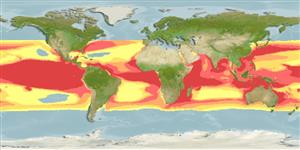Preferred temperature (Referencia
123201): 12 - 28.9, mean 26.7 °C (based on 8170 cells).
Phylogenetic diversity index (Referencia
82804): PD
50 = 0.5000 [Uniqueness, from 0.5 = low to 2.0 = high].
Bayesian length-weight: a=0.00501 (0.00408 - 0.00616), b=3.07 (3.03 - 3.11), in cm total length, based on LWR estimates for this species (Ref.
93245).
Nivel trófico (Referencia
69278): 4.5 ±0.0 se; based on diet studies.
Generation time: 9.2 (7.4 - 13.1) years. Estimated as median ln(3)/K based on 14
growth studies.
Resiliencia (Referencia
120179): Bajo, población duplicada en un tiempo mínimo de 4.5-14 años (rm=0.054; K=0.05-0.15; tm=6-10; tmax=25; Fec=2-14).
Prior r = 0.06, 95% CL = 0.04 - 0.09, Based on 3 data-limited stock assessments.
Fishing Vulnerability (Ref.
59153): Very high vulnerability (82 of 100).
🛈
Climate Vulnerability (Ref.
125649): Very high vulnerability (76 of 100).
🛈
Nutrients (Ref.
124155): Calcium = 2.41 [0.46, 12.84] mg/100g; Iron = 0.321 [0.080, 0.980] mg/100g; Protein = 22.8 [19.9, 25.0] %; Omega3 = 0.211 [0.078, 0.542] g/100g; Selenium = 34.5 [10.6, 105.0] μg/100g; VitaminA = 23 [7, 76] μg/100g; Zinc = 0.281 [0.138, 0.566] mg/100g (wet weight);
